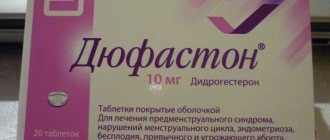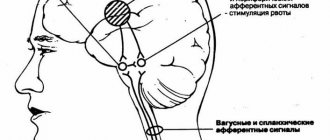Miscarriage means the termination of pregnancy before the beginning of the 22nd week, when the weight of the fetus has not yet reached 500 grams. Sometimes an interruption occurs in the first weeks after conception, when most women are not yet aware of their situation. There is a need for treatment if there is a threat of miscarriage in the early stages, especially if spontaneous abortion occurs repeatedly. Two failed pregnancies are a reason to start searching for the cause that leads to the development of this pathology.
According to statistics, about 15-20% of confirmed pregnancies end in miscarriages. Most of them occur in the early stages of embryonic development (up to 12 weeks). The most common cause is chromosomal abnormalities.
Compound
One tablet of Prajisan contains 100 or 200 mg of the active ingredient progesterone + excipients (soy lecithin, glycerol , peanut oil, water, sorbitol , gelatin, titanium dioxide).
Vaginal gel contains 80 mg of progesterone per 1 gram of the drug + sorbic acid, guar gum, liquid paraffin, hypromellose K100M, hydrogenated palm oil glyceride, water.
Pharmacodynamics and pharmacokinetics
The drug is a hormone of the corpus luteum . The hormone is able to penetrate into the nucleus of target organs and stimulate RNA and activate DNA .
Prajisan transfers the uterine mucosa to the secretion phase from the proliferative phase . Thus, specific conditions are created for the implantation of a fertilized egg to occur. The muscles of the uterus relax, the organ becomes less sensitive to the action of Oxytocin .
The active substance stimulates lipoprotein lipases , increases fat reserves, and activates the process of inducing Insulin Aldosterone production .
When the gel is applied to the mammary gland, there is a decrease in the proliferation and mitotic activity of the epithelium in the ducts. When taken orally, the permeability of the capillaries of the mammary gland tissue decreases, and the swelling of the connective stroma subsides.
The medicine is quickly and almost completely absorbed. Maximum concentration is achieved within two hours. The degree of binding of the hormone to blood plasma . The drug undergoes metabolic in liver tissue. The drug is excreted with bile and kidneys, with feces.
When using the drug vaginally, the active component accumulates in the uterus; an hour after administration, the maximum concentration of the substance is already blood
After a miscarriage - medical care tactics
Typically, a miscarriage is accompanied by increasing bleeding from the vagina and the release of clots, severe pain in the lumbar region. As a rule, treatment is not required after early spontaneous abortion. The failed mother is provided with assistance in the hospital upon her request and sent home. Sometimes the embryo dies in the uterus, but its death does not cause alarming symptoms. The doctor learns about his death only after an ultrasound and other procedures.
Treatment is aimed at the exit of the formed biological materials from the uterus, if this does not happen immediately and naturally. Several methods can be used here:
- Waiting tactics under the supervision of a specialist.
- Drug therapy.
- Surgical intervention (curettage, vacuum aspiration).
Waiting tactics involve the body naturally ridding itself of the embryo. Ideally, the amniotic sac should be released entirely, with the embryo placed inside it and the amniotic fluid discharged, although a phased release is also possible. From the moment the embryo dies in the uterus until it leaves the organ naturally, several weeks can pass. However, the medical community does not recommend setting a waiting period of more than a month. Otherwise, there is a high risk of developing sepsis due to an infection formed inside.
Treatment can also be carried out with medications, the action of which is aimed at the release of biological material from the uterine cavity as a result of its contractions. The method works well when a frozen pregnancy occurs before the 8th week.
Surgical intervention is a radical solution to the problem. To reduce the risk of an inflammatory process, experts suggest performing gynecological curettage, which involves cleaning the inner lining and inner cavity of the uterus. The procedure takes no more than 45 minutes and is performed using general anesthesia. The patient does not feel pain or discomfort, as she is immersed in a state of deep sleep. A more gentle method is vacuum aspiration, when the contents of the uterus are removed with a special suction that does not damage the tissue.
Indications for use
The drug is prescribed for various disorders associated with a lack of the hormone progesterone in the body.
Capsules taken:
- for premenstrual syndrome ;
- if there is a disturbance in the menstrual cycle due to anovulation and ovulation ;
- for fibrocystic myopathy ;
- during perimenopause ;
- when using hormone replacement therapy for perimenopause and postmenopause .
The medicine is prescribed locally:
- as hormone replacement therapy for progesterone ;
- during preparation for in vitro fertilization to prolong the luteal phase ;
- upon the onset of early menopause ;
- for the treatment of infertility due to failure to enter the luteal phase ;
- to prevent abortion due to hormonal imbalance;
- as a prophylactic for uterine fibroids or endometriosis .
Contraindications
The medicine is not prescribed:
- patients with disturbances in the blood circulation of the brain, thromboembolic disorders, including a history;
- with thrombophlebitis ;
- patients with porphyria ;
- persons suffering from liver or kidney diseases;
- if you suspect or have malignant neoplasms of the mammary glands or genital organs;
- persons with allergies to the components of the product;
- with bleeding from the genitals of unknown origin;
- after an incomplete abortion .
The solution in oil is not prescribed in the 2nd and 3rd trimester of pregnancy , as there is a tendency to form blood clots .
Preparing for a new pregnancy
Unfortunately, sometimes any tricks of doctors and couples to save the child end in failure. What happened becomes a heavy blow for both the failed mother and the father. Not wanting to come to terms with what happened, many strive to immediately conceive again, forgetting that a woman’s body has little resemblance to the incubation system. Full recovery takes time. On average, at least six months should pass before a new pregnancy. During this period, future parents gain balance, regain strength and begin to strive to achieve their goals. Do not forget that pregnancy can occur immediately after the end of menstruation. To prevent the process from becoming spontaneous and occurring unexpectedly, it is important to consult about the prescription of contraceptive drugs.
Health must be treated with special care if the first birth occurs after the age of 30 years. To be sure that things are going well, you should consult a doctor immediately after learning about pregnancy and attend every appointment he recommends.
Side effects
Of all the possible adverse reactions, the most common is allergies .
Adverse reactions from taking tablets and ointments:
- tension and swelling of the mammary glands;
- the onset of menstruation ahead of time;
- drowsiness, dizziness, nausea;
- headaches, jaundice , swelling and fluid retention in the body;
- decreased performance, skin rashes, anaphylactic shock .
For a solution in oil, the following may additionally develop:
- increased blood pressure , cholecystitis , hepatitis , visual impairment;
- thromboembolism , decreased sexual activity;
- pain at the injection site.
Instructions for use of Prajisan (Method and dosage)
The duration of administration and dosage should be determined by the attending physician, depending on the disease.
Instructions for Prajisan capsules
Inside, with plenty of liquid.
As a rule, 200 to 300 mg of the drug are prescribed, divided into 2 doses.
For premenstrual syndrome, dysmenorrhea, fibrocystic mastopathy , during premenopause , the recommended dosage is 200-400 mg per day. The course of treatment lasts from 10 to 12 days.
When introducing a capsule or cream via the vaginal route, they are inserted deep into the vagina.
During preparation for egg and women with removed testicles, 200 mg per day is prescribed, on days 13 and 14 of the menstrual cycle, from days 15 to 26 - 100 mg. In case of pregnancy, the dosage is increased by 100 mg per day every week; upon reaching the level of 600 mg per day, the dosage is divided into 3 doses. The maximum dosage of 600 mg can be taken for no more than 2 months.
In order to maintain the luteal phase in preparation for IVF , 200-600 mg per day is used during the first and second trimesters of pregnancy.
If there is a threat of abortion or for the purpose of preventing abortions due to a lack of the hormone progesterone in the body, 200-400 mg is prescribed every day, in 2 doses, in the 1st and 2nd trimester of pregnancy.
Instructions for the gel
- Open the package with the applicator.
- Remove the cap.
- Place the applicator between your middle and thumb and press the plunger with your index finger.
- The woman needs to take a “lying on her back” position, bend her knees slightly.
- Slowly insert the applicator into the vagina and press the plunger.
- Throw away the used applicator with any remaining gel.
Features of treatment in case of threat
Treatment for threatened miscarriage in the early stages depends on many circumstances. It is determined individually and depends on the results of the examination, ultrasound, blood and urine tests. The examination reveals hormonal levels, structural features of the uterus and organs of the reproductive system, and infectious processes in the body. The set of measures taken is aimed at identifying an unfavorable condition and its subsequent correction using the most effective methods.
The main goal of treatment for the threat of miscarriage in the early stages is to relieve the tone of the uterus, relax the organ, stop bleeding and prolong pregnancy if possible. However, in European countries this treatment is not considered appropriate. Experts argue that the death that occurred is the result of natural selection, when a weak and non-viable organism is destroyed, which can be facilitated by genetic abnormalities and chromosomal rearrangements.
In Russia, a different approach is practiced. A woman who is in danger of losing her fetus is prescribed bed rest, sexual rest, and physical and emotional stress is prohibited. A complete, balanced diet is recommended; in most cases, maintenance medications are indicated.
Interaction
When combining the drug with Carbamazepine , Rifampicin , barbiturates or Hydantoin , the effectiveness of the drug may be reduced.
Also, Griseofulvin and enterosorbents may reduce the effectiveness of the drug.
The medicine is combined with caution with Troleandomycin , Theophylline and Cyclosporine .
When administered intravaginally, the drug cannot be combined with various suppositories and vaginal tablets.
special instructions
When taking the drug, caution should be exercised by persons suffering from cardiovascular diseases or with depression , including a history of depression.
The medicine should not be used to protect against unwanted pregnancy.
With long-term and systematic use of the drug, it is necessary to monitor blood counts, liver function and kidney function. chloasma increases ; sun exposure and exposure to ultraviolet radiation should be limited.
When using progesterone orally, you should be careful when driving.
Pragisan
Prajisan® should not be used for contraception.
The drug should not be taken with food, since food intake increases the bioavailability of progesterone.
The drug Prajisan® should be taken with caution in patients with diseases and conditions that may be aggravated by fluid retention (arterial hypertension, cardiovascular disease, chronic renal failure, epilepsy, migraine, bronchial asthma); in patients with diabetes mellitus, mild to moderate liver dysfunction, and photosensitivity.
Patients with a history of depression should be monitored, and if severe depression develops, the drug should be discontinued.
Patients with concomitant cardiovascular diseases or a history of them should also be periodically observed by a doctor.
The use of Prajisan® after the first trimester of pregnancy may cause the development of cholestasis.
During long-term treatment with progesterone, regular medical examinations (including liver function tests) are necessary; Treatment should be discontinued if abnormal liver function tests or cholestatic jaundice are present.
When using progesterone, it is possible to reduce glucose tolerance and increase the need for insulin and other hypoglycemic drugs in patients with diabetes mellitus.
If amenorrhea occurs during treatment, pregnancy must be excluded. If the course of treatment begins very early in the menstrual cycle, especially before the 15th day of the cycle, a shortening of the menstrual cycle and/or acyclic bleeding is possible. In case of acyclic bleeding, the drug should not be used until the cause is determined, including a histological examination of the endometrium.
If there is a history of chloasma or a tendency to develop it, patients are advised to avoid UV irradiation.
More than 50% of spontaneous abortions in early pregnancy are caused by genetic disorders. In addition, the cause of spontaneous abortions in early pregnancy can be infectious processes and mechanical damage. The use of the drug Prajisan® in these cases can only lead to a delay in rejection and evacuation of a non-viable ovum. The prescription of Prajisan® for the purpose of preventing and/or treating the threat of miscarriage is justified only in cases of progesterone deficiency.
The drug contains soy lecithin, which can cause hypersensitivity reactions (urticaria and anaphylactic shock).
When conducting MHT with estrogen during perimenopause, it is recommended to use Prajisan® for at least 12 days of the menstrual cycle.
With a continuous MHT regimen in postmenopause, it is recommended to use the drug from the first day of taking estrogen.
When conducting MHT, the risk of developing venous thromboembolism (deep vein thrombosis or pulmonary embolism), the risk of developing ischemic stroke, and coronary heart disease increases.
Due to the risk of developing thromboembolic complications, you should stop using the drug if: visual disturbances such as vision loss, exophthalmos, double vision, vascular lesions of the retina: migraine; venous thromboembolism or thrombotic complications, regardless of their location.
If there is a history of thrombophlebitis, the patient should be closely monitored.
When using Prajisan® with estrogen-containing drugs, you should refer to the instructions for their use regarding the risks of venous thromboembolism.
The results of the Women Health Initiative Study (WHI) clinical study indicate a slight increase in the risk of breast cancer with long-term, more than 5 years, combined use of estrogen-containing drugs with synthetic gestagens. It is unknown whether there is an increased risk of breast cancer in postmenopausal women when undergoing MHT with estrogen-containing drugs in combination with progesterone.
The WHI study also found an increased risk of dementia when starting MHT after age 65 years.
Before starting MHT and regularly during it, a woman should be examined to identify contraindications to its implementation. If clinically indicated, a breast examination and gynecological examination should be performed.
The use of progesterone may affect the results of some laboratory tests, including liver and thyroid function tests; coagulation parameters; pregnanediol concentration.
Analogs
Matches by level 4 ATX code:
Iprozhin
Utrozhestan
Crinon
Progesterone
Progestogel
There are the following analogues of this drug: Krainon, Progesterone, Iprozhin, Prozhestogel, Utrozhestan .
Reviews about Prajisana
There are generally good reviews on the Internet about the medicine if you use it according to your doctor's recommendations.
Reviews of Prajisana on forums:
- “I took the drug to get rid of pain before my period. The medicine significantly relieved all my pain. I advise you to buy...”
- “After I took the first pill, I felt bad, dizzy, nauseous, and there was a vacuum in my ears, I felt unwell all day...”
- “My sister took pills during pregnancy. I carried and gave birth, everything is fine...”
Preventing the threat of miscarriage
Despite the many reasons why a miscarriage can occur, there are ways to reduce the risk of developing an anomaly during pregnancy. Measures to prevent spontaneous abortion form a solid basis of recommendations in preparation for conception. They affect both parents, not just the woman.
A couple who decides to have a child is advised to take care of their own health at the planning stage. It is advisable to undergo genetic compatibility testing. Do not despair if tests reveal a low degree of compatibility for having children. Treatment for threatened miscarriage in the early stages will begin long before there is a danger of fetal loss.
It is also important for both partners to be tested for hidden infections, many of which can be transmitted to the baby during pregnancy, causing multiple malformations and deformities. For preventive purposes, in order to minimize the possibility of the need for treatment after a miscarriage, it is recommended to avoid public places with large crowds of people. Some types of infections are transmitted by airborne droplets, so infection often occurs spontaneously, remaining unattended until the consequences appear. Do not come into contact with their possible carriers; when influenza and acute respiratory infections become more active, try to stay at home more.
A man and woman who decide to become parents should try to eradicate bad habits - smoking, alcohol abuse and drug addiction. A well-balanced diet and properly selected vitamins will help you lose excess weight, improve your health and improve your well-being. A woman should avoid heavy lifting, excessive physical exertion, abdominal impacts, hypothermia, and overheating in the sun.










